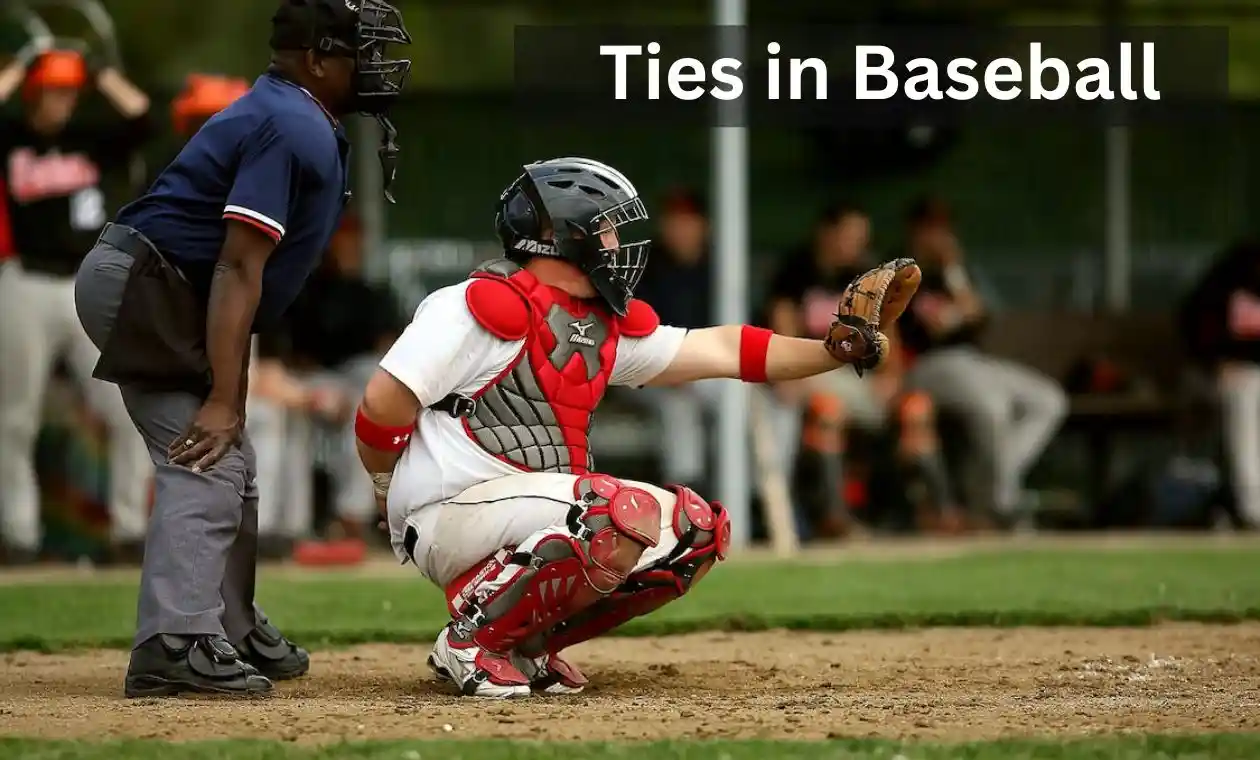
In the dynamic world of baseball, where victories and defeats often take center stage, the concept of ties introduces a unique and intriguing element. Unlike many other sports, baseball can end in a tie, sparking curiosity and questions among fans and enthusiasts.
Ties occur when both teams finish a game with an equal score, leaving neither in clear triumph nor defeat. While ties are relatively rare in baseball, their occurrence can significantly impact team standings, playoff scenarios, and the overall narrative of a season.
Understanding ties in baseball is crucial for fans and players alike. It not only adds complexity to the game but also influences strategic decisions and gameplay dynamics. This blog will delve into the intricacies of ties, exploring their historical context, the evolution of tiebreaker rules, and the implications of a game-ending without a decisive winner.
Whether you’re a seasoned baseball aficionado or a newcomer to the sport, grasping the nuances of ties will enhance your appreciation for the game. Join us on a journey to unravel the mysteries of ties in baseball, as we navigate through rules, outcomes, and frequently asked questions. Let’s embark on this exploration together, shedding light on a lesser-explored facet of America’s favorite pastime.
Do Ties Exist in Baseball?
Delving into the archives of baseball history unveils a tapestry woven with dramatic victories, heartbreaking defeats, and an occasional enigma—the tie game. In the early chapters of the sport, ties were not uncommon. A testament to the unpredictability of the game, they added an extra layer of suspense and left fans on the edge of their seats.
As baseball evolved, so did its rules, and the treatment of ties underwent significant transformations. What was once an accepted outcome now became a rarity, prompting adjustments in the rulebook to ensure the game’s competitive edge. The evolving stance on ties reflects the sport’s commitment to maintaining excitement, fair play, and a clear determination of winners and losers.
This journey through the historical ebb and flow of ties in baseball will unearth tales of bygone eras when a game’s conclusion didn’t always declare a victor. We’ll navigate through the twists and turns of rule changes, exploring the impact on player strategies, team dynamics, and the overall fan experience. So, fasten your seatbelts as we unravel the captivating saga of ties in baseball, where history meets the ever-changing spirit of the game.
What Happens in Baseball if There’s a Tie?
In the theater of baseball, where every inning unfolds like a scene in an epic drama, the emergence of a tie injects an air of uncertainty and anticipation. So, what transpires when the dust settles, and neither team emerges as the undisputed conqueror?
Enter the realm of tiebreaker rules—a set of strategic maneuvers and electrifying plays designed to untangle the web of equality. Imagine an extra-inning shootout, where teams engage in a battle of wits, skill, and sheer determination to clinch victory. These tiebreaker duels not only showcase the resilience of players but also captivate audiences with nail-biting suspense.
But the ripples of a tie extend beyond the diamond. In the intricate dance of standings and playoffs, a tie can be a game-changer. It’s not merely a shared result; it’s a pivotal moment that can shape the destiny of a team’s postseason journey. The impact reverberates through the standings, influencing rankings, wildcard races, and the pursuit of that coveted championship title.
So, as we explore the intricacies of tiebreaker rules, prepare to be immersed in the high-stakes drama that unfolds when baseball refuses to settle for a mere draw. Join us as we dissect the repercussions of ties on standings and playoffs, where each tiebreaker pitch becomes a defining moment in the grand narrative of the baseball season. The game is on, and the stakes have never been higher!
Does a Tie Count as a Win in Baseball?
In the symphony of wins and losses that define baseball, the concept of a tie introduces a captivating pause—an intriguing intermission where neither victory nor defeat claims the spotlight. But does this harmonious stalemate count as a win?
Let’s unravel the scorebook mysteries and dive into the heart of win-loss records. Unlike a clear-cut win, a tie sits in the twilight zone—a unique entry that neither boosts the triumphs nor burdens the losses. It’s a moment frozen in the statistics, challenging the conventional narrative of dominance and submission.
Yet, the influence of ties extends far beyond the individual player’s record. Like a subtle undercurrent, ties weave into the intricate fabric of team standings, shaping the landscape of competitiveness. We embark on a journey of analysis, exploring how ties act as pivotal turning points, affecting the trajectory of a team’s journey through the season.
So, prepare for a rollercoaster of insights as we demystify the enigma of ties in baseball. This is not just a question of wins and losses—it’s an exploration of the nuanced dance between ties and triumphs that echoes through the corridors of baseball history. Welcome to the intersection where ties defy the conventional, and the game’s narrative takes an unexpected twist!
How Many Innings Can Baseball Go?
In the timeless dance of innings, baseball unfolds its narrative inning by inning, each frame a chapter in the epic tale of competition and skill. But as the game progresses, one might wonder: Is there a limit to this rhythmic back-and-forth?
Let’s start with the basics—the standard innings. The traditional nine innings, a poetic balance of offense and defense, have defined baseball for generations. Yet, the allure of the game lies not just in its adherence to tradition but also in its capacity to surprise.
Enter the realm of extra innings—a realm where time seems to stretch, and the intensity of the game reaches a crescendo. Here, the drama unfolds beyond the regulation nine, and the players, like modern-day gladiators, battle on. A tied game becomes the gateway to an extended saga, an exploration of resilience, strategy, and sheer will.
Join us on this journey as we navigate through the innings, discovering the artistry of standard play and the unpredictability of extra innings. It’s not just about how many innings baseball can go; it’s an exploration of the endurance, strategy, and heart that make every extra inning a captivating chapter in the book of baseball history. So, fasten your seatbelts as we embark on a quest through the innings—a quest where the game’s heartbeat defies the constraints of time and tradition.
Comparisons with Other Sports
As we journey through the realm of ties in baseball, it’s intriguing to peek over the fences and see how other sports navigate the delicate balance between victory and draw. Each sport, like a distinct flavor in the world of athletics, has its recipe for handling ties—a unique blend of rules, drama, and sportsmanship.
Picture the soccer pitch, where a well-fought match can conclude in a shared celebration of goals and grit. The world’s most popular sport often embraces ties as a testament to evenly matched teams and the beauty of competition without a clear victor.
In the fast-paced arena of hockey, sudden-death overtime and shootouts add an extra layer of suspense. A tied hockey game transforms into a high-stakes showdown, where precision and nerves of steel often determine the winner.
And then there’s the gridiron ballet of football, where ties are a rare gem. Overtime rules create a theatrical encore, providing teams with a chance to break the deadlock and emerge as the undisputed hero of the day.
As we draw comparisons with other sports, we discover that the treatment of ties is a nuanced dance, reflective of each sport’s ethos and spirit. Join us in this exploration of ties across sports, where the universal theme of competition takes center stage, and the varied approaches paint a colorful canvas of athletic diversity. It’s a journey that transcends the boundaries of baseball, inviting us to appreciate the rich tapestry of ties in the broader world of sports.
Conclusion: Unraveling the Tapestry of Ties in Baseball
In the intricate dance between victories and ties, our exploration into the world of tied baseball games has uncovered a rich tapestry of history, rules, and strategic intricacies. From the evolution of ties over time to the high-stakes drama of tiebreaker rules and their ripple effects on standings and playoffs, we’ve ventured into the heart of a less-explored facet of America’s favorite pastime.
As we conclude our journey, it’s evident that ties are not merely a statistical anomaly; they are moments frozen in time, challenging the conventional narrative of triumphs and defeats. The standard innings, the drama of extra innings, and the comparisons with other sports have added layers to our understanding of ties in baseball, showcasing the sport’s dynamic nature.
We invite you, our fellow fans and enthusiasts, to share your thoughts and experiences with ties to baseball. What are your most memorable tied games? How do you feel about tiebreaker rules? Engage with us in the comments section below, and let’s continue the conversation. Baseball’s narrative is ever-evolving, and your perspectives contribute to the vibrant community that celebrates the beauty, unpredictability, and enduring spirit of the game.
Thank you for joining us on this exploration. Stay tuned for more captivating insights into the world of baseball on BaseballProPicks.com!

Meet Daniel Anderson, the heart and soul behind Baseball Pro Picks. At 49, Daniel’s life has revolved around baseball, a passion that’s as strong today as it was when he first fell in love with the game. Living in the USA, Daniel has dedicated countless hours to watching, analyzing, and understanding every pitch, hit, and home run, making almost no game missed. His deep-rooted love for the sport is matched only by his commitment to sharing insightful, expert analysis with fellow baseball enthusiasts. With decades of experience and a keen eye for the game’s nuances, Daniel brings a unique perspective that enriches Baseball Pro Picks. Trust Daniel to guide you through the intricacies of baseball with the authority and trustworthiness of a true aficionado.












